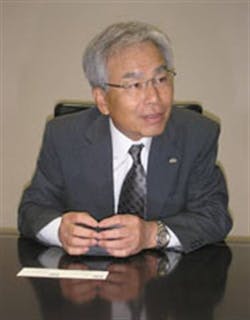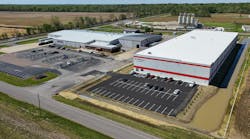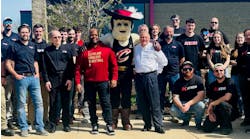Kenji Nakakura is a humble man, who jokes that he doesn’t know how he became the chief executive officer of Toyo Tire & Rubber Co. Ltd.
“I was suddenly called up to be president and CEO at the end of last year, so I was not prepared,” he says.
After talking with him, however, it quickly becomes apparent why he was chosen to lead the 11th largest tire manufacturer in the world.
* As an engineer, Nakakura, 60, has been involved with OTR tire production since 1971, when he joined the company, and passenger tire development since the mid-1990s.
* He helped develop two tire production methodologies, including ATOM, Toyo’s Advanced Tire Operation Module manufacturing system.
* He spent the eight months prior to his big promotion in the non-tire segment of the business.
He even was put in charge of the company’s computer systems in 1987, which included the installation of a supercomputer. “So I got to see the company as a whole,” says Nakakura.
That’s the key: He sees the big picture.
[PAGEBREAK]
New plant in Europe
There are only a few ways to increase your annual tire manufacturing capacity from 30 million tires to 50 million in seven years. One of them is building at least one additional tire plant.
That’s the plan, and Europe is the next target, according to Nakakura. Toyo previously announced it was planning to open a plant in Asia around 2011. “These new factories would be based on the ATOM method. ATOM can be expanded by block because in the pre-stage, you don’t need any large areas.”
Toyo produced 30 million tires in seven plants in 2007. Its two wholly-owned Japanese consumer tire facilities accounted for 80% of the total.
By 2015, overseas production will account for 50% of all Toyo tires produced annually, with three million high performance tires coming from a yet-to-be-determined location in Europe.
Some six million additional tires will come from two expansions at the Toyo Tire North American Manufacturing Inc. plant in White, Ga., which produces two million passenger and light truck tires a year.
Toyo is investing $270 million to increase volume to 5.2 million tires per year by 2011 as part of the first stage. The final stage will require constructing a new building at the site, says Nakakura.
Worldwide alliances
When Bridgestone Corp. approached Toyo earlier this year about forming a business alliance, Nakakura was comfortable with the idea. And why not? Both he and Toyo have worked with other tire companies for decades.
Nakakura came to the United States for the first time in 1975 to visit General Tire & Rubber Co. in Akron, Ohio. “We used to have a technical alliance with General Tire,” he says. “At the time, we were trying to take our (bias) off-the-road products and make them radial tires. And at the time, General Tire (was working on) a prototype.”
[PAGEBREAK]
Although that alliance didn’t prove fruitful, Toyo eventually did radialize its OTR tire line through Nippon Giant Tire Co. Ltd., a joint venture with Goodyear Tire & Rubber Co. and Mitsubishi Corp. Goodyear is the majority owner in the Tatsuno, Japan, OTR tire plant.
“Goodyear had a lot of wonderful technologies, so for me it was (a kind of) culture shock. It was a world I did not know about before, and it surprised me — and moved me emotionally as well.”
Over the years, Toyo also has teamed up with Continental AG, Yokohama Rubber Co. Ltd. and Cheng Shin Rubber Industry Co. Ltd. to produce tires. In 1988, Continental, Toyo and Yokohama opened the GTY truck tire plant in Mount Vernon, Ill.
Toyo and Cheng Shin run two joint venture tire manufacturing plants in China. They also share product and material technology through a technical alliance.
Under the terms of what Nakakura refers to as a “soft alliance” with Bridgestone, the parties will not compete in Japan. “We believe we need to expand, targeting the world outside Japan,” he says.
They will share production technologies with each other, and take advantage of their “purchasing capabilities” while maintaining their independence. As part of the alliance, Bridgestone, which is 10 times the size of Toyo, will receive interest in Toyo, and vice versa.
Nitto in the U.S.
Toyo’s Nitto brand has very little presence in Japan. That does not make it an associate brand in the U.S., however.
“From our viewpoint, we position Nitto and Toyo the same,” says Nakakura, who, along with current Nitto Tire U.S.A. Inc. President Tomo Mizutani, spearheaded Nitto’s growth in the U.S.
Market research conducted by Mizutani in the mid-1990s led to Nitto’s niche strategy of targeting the tuner market with very low-profile, high performance tires. Young people “were buying Honda cars with 14-inch tires at the time, tuning them up or raising the horsepower and riding them,” says Nakakura. “We were suggesting 18 inches!”
That strategy has been broadened since then. And as more capacity becomes available, Nakakura hopes to grow the brand globally as well.
Half of the Nitto tires sold in the U.S. are manufactured at the White, Ga., facility. The other half is produced in Japan.
Independent thoughts
Both the Toyo and Nitto brands are sold only through the independent tire dealer channel.
“We want to co-exist with our dealers and (favor) independent dealers and work with them,” says Nakakura. “We want to help them and prosper together.
“Toyo is, as you know, not a large company, but we manufacture good products that people want or need. We will continue to do that."





